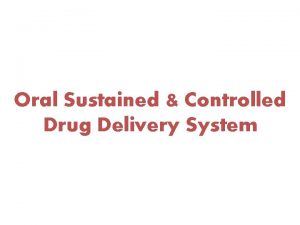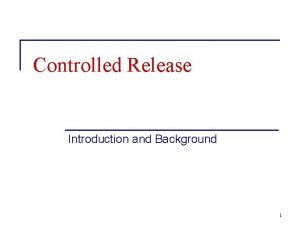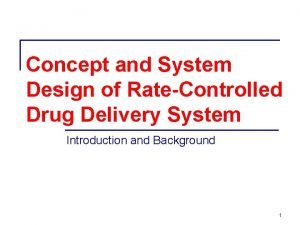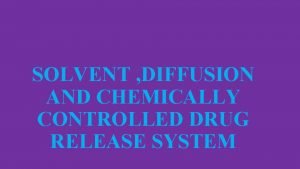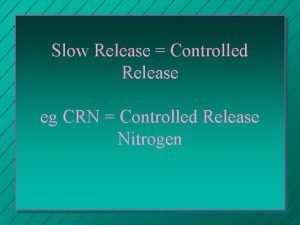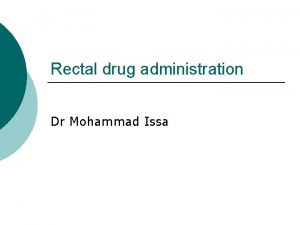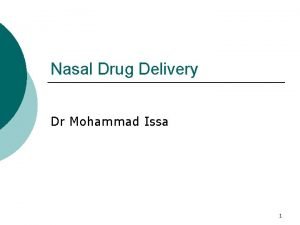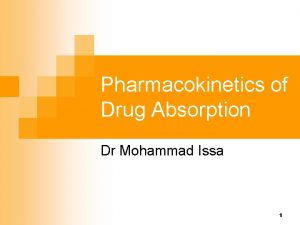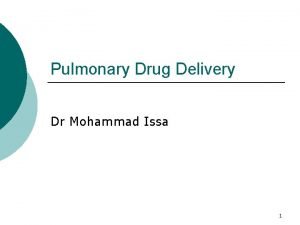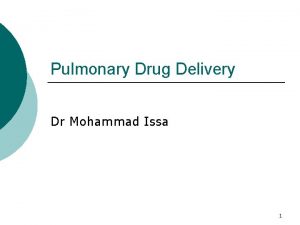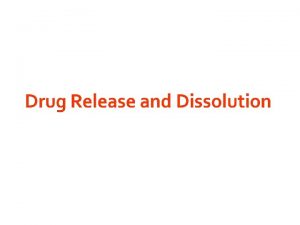Controlled drug release Dr Mohammad Issa 1 Frequency
















- Slides: 16

Controlled drug release Dr Mohammad Issa 1

Frequency of dosing and therapeutic index ¡ Therapeutic index (TI) is described as the ratio of the maximum drug conc in the blood that can be tolerated to the minimum drug conc needed to produce a satisfactory clinical response. In some cases these ranges are narrow, resulting in small therapeutic index ¡ We seek to maintain drug conc in blood within the Therapeutic range during therapy. This requires not only the selection of an appropriate daily dose, the drug must also be given with sufficient frequency so as to minimize the range of blood conc that are produced. The ratio of max to minimum drug conc at steady state should not exceed therapeutic index of the drug. 2

Frequency of dosing and therapeutic index ¡ For drugs that are absorbed and distributed rapidly, the following relation apply 3

Frequency of dosing and therapeutic index ¡ ¡ A drug with the TI of 2, t 1/2 of 3 hrs must be given no less frequently than every 3 hours A drug with similar half life but a therapeutic index of 4 may be given every 6 hours 4

Absorption rate and frequency of dosing ¡ Dosing regimen for rapidly absorbed drugs are a function of the pharmacodynamics and pharmacokinetics of the drug molecule, they must be based on therapeutic index and half life of the drug ¡ Reducing the absorption rate of a drug by controlling the rate of drug release in the dosage form, can dramatically affect drug conc at steady state ¡ For a given formula, the slower the release of the drug, the smaller is the ratio of maximum to minimum drug con at steady state. Under these conditions, we can give larger doses at less frequent intervals and still stay within the 5 therapeutic conc of the drug

Absorption rate and frequency of dosing ¡ Prolonged release medication offer obvious advantages for drugs with short half lives and narrow therapeutic indices. As they permit the drug to be given at more reasonable intervals within the day (improve patient compliance) ¡ They also minimize the peak to trough drug conc ratio, which may be useful for many drugs. ¡ For example: potassium depleting hydrocholrthiazides: their potassium depleting effect disappears when the fluctuations in blood levels decrease. Nephrotoxicity of gentamicin is reduced when steady state conc are reached and maintained in a narrow range. 6

Zero order release ¡ Continuous, constant rate IV infusion leads to constant blood levels. Under these conditions blood levels are invariant with time, there are no peaks and troughs ¡ Provided that the constant drug conc is within therapeutic range, this is an ideal situation for many drugs ¡ The only way to achieve constant blood levels is to administer the drug at a constant (zeroorder) rate over the entire dosing interval. 7

Zero order release ¡ Fluctuations in blood levels do occur as a result of transient changes in clearance or in the delivery rate, but they are usually small ¡ Constant rate release is not limited to infusion, today there are dosage forms oral, ocular, intravaginal, IM that release the drug in a zero order or near zero order fashion. 8

Oral prolonged release medications ¡ Most prolonged release medications are intended for oral use. A prolonged release unit usually contains more drug than a conventional dosage unit, but it intended to be given less frequently ¡ A drug that is usually administered at a dose of 250 mg 4 times daily, may be given at a dose of 500 mg twice daily, or 1 gm once daily 9

Oral prolonged release medications ¡ The ultimate criteria of for evaluating such dosage forms are: the amount of drug intended to be absorbed is indeed absorbed in a predictable and consistent manner 2. the steady state ratio of maximum to minimum drug conc is no greater or optimally less than that produced by the more frequently administered conventional dosage forms 1. 10

Potential advantages oral prolonged release medications 1. Improved control of the maintenance therapuetic level of the drug which permit: l l l improved treatment of many chronic illnesses where symptoms breakthrough occurs if plasma levels went down (asthma, depression) maintenance of therapeutic action during night (management of pain) reduction in the incidence and severity of side effects caused by increased plasma levels 2. improved patient compliance 3. reduction of the incidence and severity of gastrointestinal side effects caused by irritant drugs administered in a conventional dosage form 11

Potential limitations oral prolonged release medications 1. variable physiological factors (gastric emptying, gastric and intestinal transit rate, food) which often influence drug bioavailability of conventional dosage form may also interfere with the precision of control of release of the SR dosage forms 2. the rate of transit of the sustained release oral dosage form along the GI limits the maximum period of time for which therapeutic response is maintained 3. Sustained release dosage forms which tend to remain intact, may become lodged at some sit of the GI--- slow release, high localized conc of drug, local irritation 12

Potential limitations oral prolonged release medications 4. Reduced potential for accurate dosage adjustment: fine dose adjustment is difficult. 5. Dose dumping: uncontrolled rapid release of the drug material due to failure of the formulation which result in abnormal high blood levels of circulating drug 13

Controlling drug release ¡ All sustained release formulations employ a chemical or physical barrier to provide slow release of the drug ¡ Use of drug derivatives with reduced solubility or dissolution rate: increase particle size, less soluble complexes and salts, ion exchange resins to bind the drug, use of coating, embedding the drug in a wax, fat, or inert matrices. 14

Subdivided vs. single unit ¡ Most peroral dosage forms can be characterized as being subdivided or single unit. ¡ Subdivided: hard gelatin capsule containing numerous beads in which the drug is entrapped, . Often several kinds of beads (pellets) are found in a capsule, some releasing the drug rapidly and other more slowly ¡ Single unit: remain more or less intact throughout the GIT, releasing the drug slowly as it passes through ¡ It is judged that subdivided dosage forms are potentially safer than intact or single unit dosage form 15

16
 Sustained release dosage form
Sustained release dosage form Nocoderm
Nocoderm Extended release vs sustained release
Extended release vs sustained release Diffusion controlled modified release system consists of
Diffusion controlled modified release system consists of Example of substitution with exhausted drug is
Example of substitution with exhausted drug is Nabil baki
Nabil baki Issa saleh
Issa saleh Two voice poem examples funny
Two voice poem examples funny Issa ottawa
Issa ottawa Issa raleigh
Issa raleigh Issa tb 109
Issa tb 109 Anwar issa
Anwar issa Dr nabil khouri
Dr nabil khouri Ghassan issa
Ghassan issa Opt notre dame
Opt notre dame Amanda issa
Amanda issa 6 steps of risk management framework
6 steps of risk management framework
